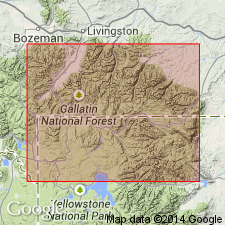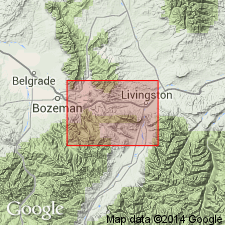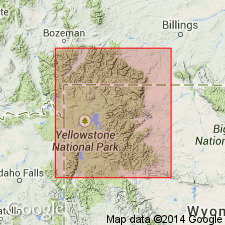
- Usage in publication:
-
- Hyalite Peak Volcanics
- Modifications:
-
- Named
- Dominant lithology:
-
- Andesite
- Breccia
- AAPG geologic province:
-
- Montana folded belt
Summary:
Named (no type locality designated) for exposures near Hyalite Peak, Park Co, MT in the Montana folded belt province. Fridley Peak quad extends into Gallatin Co, MT. Representative section measured 3.8 mi north of Hyalite Peak on east wall of West Fork Middle Creek Canyon, sec 2, T5S, R6E where the formation is 2,830 ft thick. Is 2,800+ ft thick on Big Creek. May be more than 4,000 ft thick. Top of sequence is eroded. Unconformably overlies Golmeyer Creek Volcanics (new). Is more widespread than Golmeyer Creek. Consists of lava flows that are massive, blocky to columnar-jointed, microcrystalline to hypocrystalline, locally porphyritic andesite. Grades into breccia laterally and vertically. Breccias are generally monolithologic, subangular to rounded, generally oxidized, and range to as much as several ft in diameter. Epiclastic breccias, crudely stratified, occur throughout composed mostly of andesite and dacite fragments. These epiclastic breccias probably deposited as viscous to soupy mudflows, and as stream or sheetwash deposits. Conglomerates locally at base are thought to be fluvial and debris flow deposits. Lavas extruded from a northwest zone of fissures. Flows are intruded by a dacite dated at 49.5 +/-1.5 m.y. and are thought to be Wasatchian or early Bridgerian, or Eocene age.
Source: GNU records (USGS DDS-6; Denver GNULEX).

- Usage in publication:
-
- Hyalite Peak Volcanics*
- Modifications:
-
- Overview
- AAPG geologic province:
-
- Montana folded belt
Summary:
Is a name adopted for a sequence of andesitic flows and flow breccias thought to be the youngest volcanic unit in the northern Gallatin Range, Gallatin Co, MT in the Montana folded belt province. Unconformably overlies Cathedral Cliffs? Formation. Is about 1,500 ft thick at Maxey Ridge and thickens southward. Is probably equivalent to the early basic breccia of Hague (1899). Assigned to the Eocene.
Source: GNU records (USGS DDS-6; Denver GNULEX).

- Usage in publication:
-
- Hyalite Peak Volcanics*
- Modifications:
-
- Revised
- AAPG geologic province:
-
- Montana folded belt
Summary:
Assigned to the newly named Washburn Group of Absaroka Volcanic Supergroup. Is known in the northeastern part of the Gallatin Range, Montana folded belt province, MT, where it grades into Sepulcher Formation (new) of Washburn Group (new) of Absaroka Volcanic Supergroup (new) of Yellowstone National Park. Overlies Golmeyer Creek Volcanics, also of Washburn Group. Is of middle Eocene age.
Source: GNU records (USGS DDS-6; Denver GNULEX).
For more information, please contact Nancy Stamm, Geologic Names Committee Secretary.
Asterisk (*) indicates published by U.S. Geological Survey authors.
"No current usage" (†) implies that a name has been abandoned or has fallen into disuse. Former usage and, if known, replacement name given in parentheses ( ).
Slash (/) indicates name conflicts with nomenclatural guidelines (CSN, 1933; ACSN, 1961, 1970; NACSN, 1983, 2005, 2021). May be explained within brackets ([ ]).

